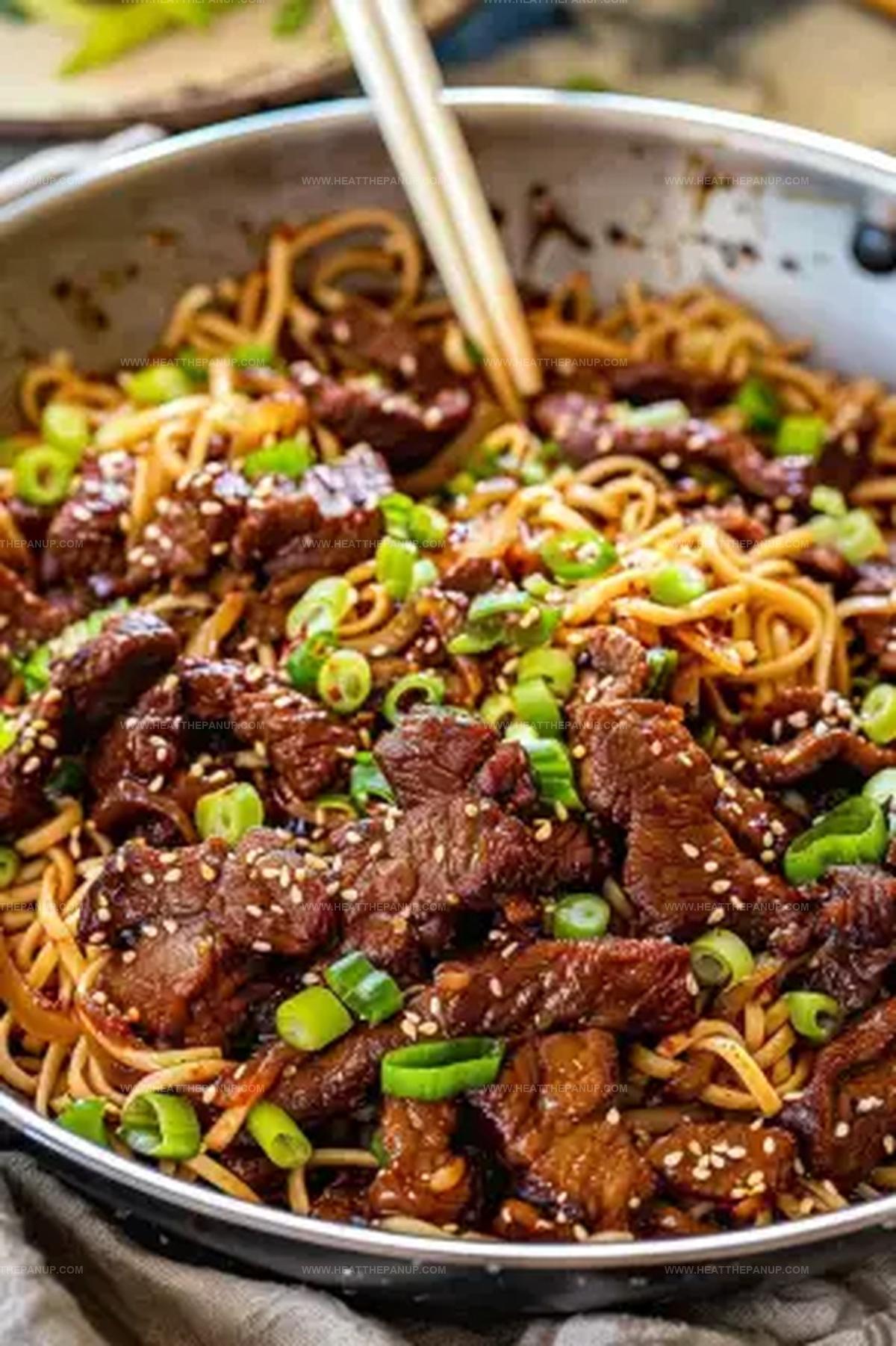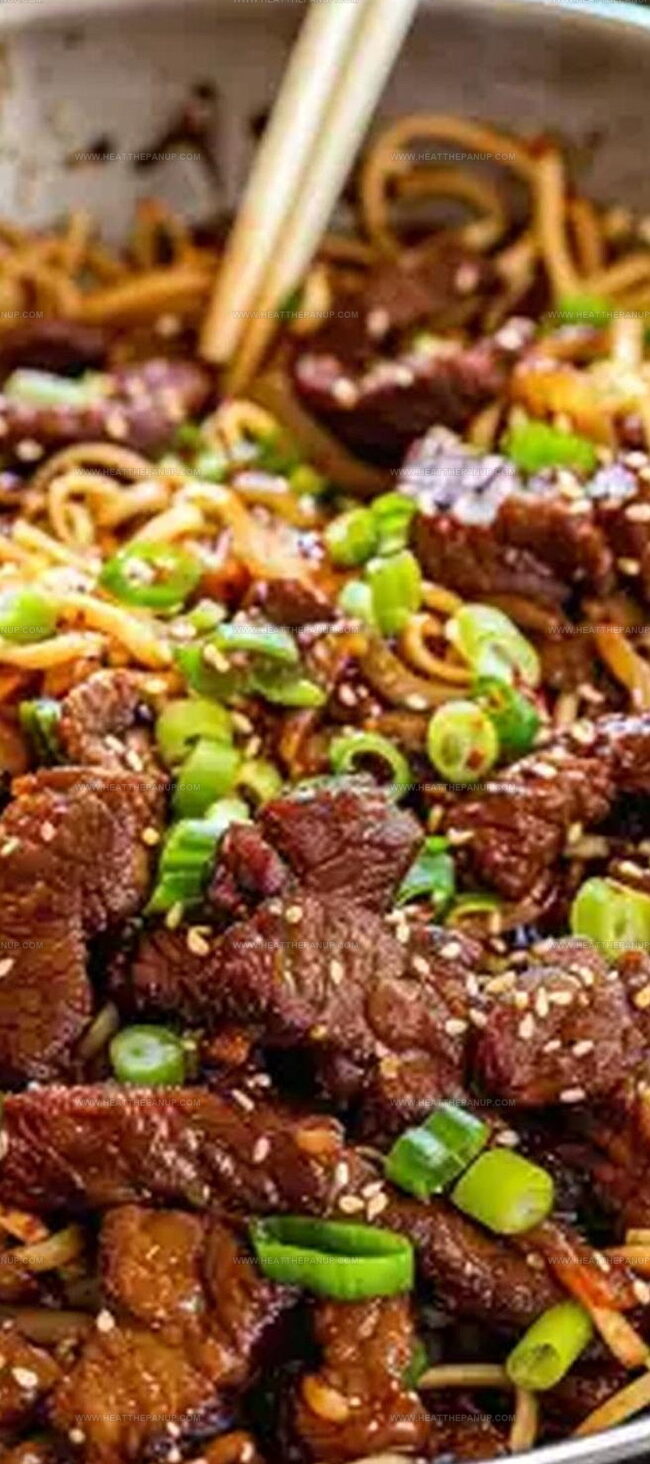Savory Mongolian Beef Noodles Recipe: A Bowl of Cozy Joy
Spicy, saucy mongolian beef noodles dance with rich flavors that will instantly captivate your taste buds.
Tender strips of meat nestle among silky strands, creating a perfect harmony of textures.
Vibrant aromatics like garlic and ginger infuse each bite with incredible depth.
Hailing from traditional asian cuisine, this dish promises an authentic culinary adventure.
Quick and simple techniques make it accessible for home cooks seeking restaurant-quality meals.
Chopsticks ready?
Noodles with Sweet and Savory Mongolian Flair
Mongolian Beef Noodles: Everything You’ll Need
Main Ingredients:Sauce Ingredients:Vegetable and Garnish Ingredients:Coating and Cooking Ingredients:Mongolian Beef Noodles Step by Step
Step 1: Slice Beef Perfectly
Grab your flank steak and slice it super thin against the grain. Dust each slice completely with cornstarch, ensuring every piece gets an even, light coating.
Step 2: Sear Beef to Golden Perfection
Fire up a large skillet or wok with vegetable oil on medium-high heat. Cook beef in batches, letting each piece turn beautifully golden and crispy. This should take about 2-3 minutes per side. Once done, set aside on a plate.
Step 3: Soften Bell Peppers
In the same skillet, quickly sauté the green bell peppers until they become tender and slightly soft. This will take around 3-4 minutes. Transfer peppers alongside the beef.
Step 4: Prepare Noodles
Cook ramen noodles following package directions. Drain completely and set aside.
Step 5: Create Aromatic Base
Warm sesame oil in the skillet over medium heat. Add minced garlic and red pepper flakes, stirring until their incredible fragrance fills your kitchen, which takes about 1 minute.
Step 6: Build Flavorful Sauce
Pour in soy sauce, brown sugar, and chicken broth into the skillet. Stir ingredients thoroughly and let the mixture simmer gently.
Step 7: Combine Everything
Return beef and bell peppers to the skillet with the sauce. Add cooked noodles and toss everything together until each ingredient is beautifully coated.
Step 8: Garnish and Serve
Sprinkle freshly chopped green onions over the top. Serve piping hot and enjoy your delicious Mongolian Beef Noodles!
Smart Notes for Mongolian Beef Noodles
Mongolian Beef Noodles Easy Tips To Save The Leftovers
Mongolian Noodles Go Well With
Mongolian Beef Noodles: Spicy Sauce Ideas
FAQs
Cornstarch creates a thin crispy layer on the beef, helping it brown quickly and seal in moisture while giving a nice textural crunch to the dish.
Flank steak works best, but you can substitute with sirloin or skirt steak if needed. Just ensure you slice the meat against the grain for tenderness.
The red pepper flakes provide a mild heat. You can adjust the spiciness by increasing or reducing the amount of red pepper flakes to suit your taste preference.
Cook the beef in batches and avoid overcrowding the pan. Quick, high-heat cooking and slicing against the grain will help keep the meat tender and juicy.
Print
Mongolian Beef Noodles Recipe
- Total Time: 35 minutes
- Yield: 4 1x
Description
Savory Mongolian Beef Noodles dance with bold flavors from Chinese cuisine, blending tender beef strips and silky noodles in a rich, tangy sauce. Spicy, sweet, and utterly irresistible, this dish promises a quick culinary journey you’ll crave again and again.
Ingredients
Main Protein:
- 1.5 pounds (1.5 lbs) flank steak
Vegetables:
- 1 green bell pepper, thinly sliced
- 3 green onions, chopped
Pantry and Sauce Ingredients:
- 1/4 cup cornstarch
- 1/4 cup vegetable oil
- 8 ounces (8 oz) ramen noodles
Instructions
- Slice flank steak against the grain into thin strips, ensuring even cuts for consistent cooking texture.
- Thoroughly coat beef strips with cornstarch, creating a light, crispy exterior that will enhance flavor and browning.
- Heat vegetable oil in a large skillet or wok over medium-high temperature, preparing for rapid searing of meat.
- Cook beef in small batches to prevent overcrowding, achieving a golden-brown crust and crispy edges in approximately 2-3 minutes per side.
- Remove beef and set aside, keeping the pan’s flavorful remnants for subsequent cooking stages.
- Sauté green bell peppers in the same skillet until they soften and develop slight caramelization, approximately 3-4 minutes.
- Prepare ramen noodles according to package instructions, ensuring they remain firm and do not become mushy.
- In a clean skillet, warm sesame oil over medium heat to release its distinctive nutty aroma.
- Add minced garlic and red pepper flakes, stirring quickly to prevent burning and develop a fragrant base.
- Pour soy sauce, brown sugar, and chicken broth into the skillet, creating a rich, glossy sauce with balanced sweet and savory notes.
- Gently reintroduce seared beef and sautéed peppers into the simmering sauce, allowing ingredients to meld together.
- Incorporate cooked noodles, tossing thoroughly to ensure each strand is evenly coated with the flavorful sauce.
- Garnish with freshly chopped green onions for a bright, crisp finish and serve immediately while hot.
Notes
- Slice beef against the grain to ensure tenderness and easy chewing, preventing tough, chewy meat.
- Pat beef dry before coating with cornstarch to achieve a crispier, golden-brown exterior during cooking.
- Use high heat when searing beef to create a delicious caramelized crust while keeping the inside juicy.
- Consider using gluten-free tamari instead of soy sauce for a celiac-friendly version of the dish.
- Add extra red pepper flakes for more heat or reduce for a milder flavor profile.
- Swap ramen noodles with zucchini noodles or rice noodles for a low-carb or alternative texture option.
- Prep Time: 15 minutes
- Cook Time: 20 minutes
- Category: Dinner, Lunch
- Method: Sautéing
- Cuisine: Mongolian
Nutrition
- Serving Size: 4
- Calories: 680
- Sugar: 2 g
- Sodium: 900 mg
- Fat: 34 g
- Saturated Fat: 5 g
- Unsaturated Fat: 25 g
- Trans Fat: 0 g
- Carbohydrates: 70 g
- Fiber: 3 g
- Protein: 38 g
- Cholesterol: 80 mg




James Hambly
Founder & Recipe Creator
Expertise
Recipe Development, Culinary Education, Farm-to-Table Cooking, Southern Cuisine
Education
Asheville-Buncombe Technical Community College
Certificate in Culinary Arts
Focus: Hands-on training in professional cooking techniques, emphasizing farm-to-table practices and Southern cuisine.
The Chef’s Academy
Associate Degree in Culinary Arts
Focus: Comprehensive culinary education covering global cuisines, kitchen management, and food safety.
James grew up surrounded by the smells of cast-iron skillets and slow-cooked Southern meals in Asheville, North Carolina.
He sharpened his skills with a Certificate in Culinary Arts from Asheville-Buncombe Technical Community College, and later leveled up with an Associate Degree from The Chef’s Academy.
James’s philosophy is simple: the best meals don’t need fancy tricks, just fresh ingredients, a hot pan, and a little bit of heart. His favorite days are spent testing one-pan wonders, chasing bold flavors, and creating recipes that feel easy, even on a busy night.